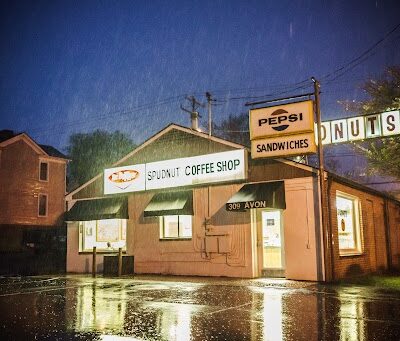I don’t think I can do better than to quote the curators of the show in Second Street’s Dové Gallery, which gathers an international collection of art that’s influenced by comics. Think of these pieces as “graphic poems rather than graphic novels,” Warren Craghead and Pedro Moura suggest. It’s a fruitful approach. Even though the familiar notion of comics (namely, a narrative told through panels of text and illustration) is obviously present here, the thing to seek in this room is not plot, but gesture.
|
READ ON • For more on "Impera et Divide," including background on co-curator Warren Craghead and a video tour of the exhibit, click here. |
Ivan Manouach’s pencil-drawn skeleton, for example, at sea in a small oarless boat, finds what seems to be a beheaded, plucked chicken in the water. He puts it to his mouth and blows it up like a balloon until it’s as big as he is. Nearby panels show a blur of motion where the boat was—maybe a brawl between skeleton and chicken, maybe a storm that’s capsizing the craft—but the sequence, and therefore the meaning, of the events is deliberately unclear. What remains is the feeling of solitude, helplessness, and being either a survivor or a pending victim of an overwhelming force.
In the case of Frédéric Coché’s images, which are delicate and vaguely violent drawings of medieval walled towns, ships, men hunting with hounds, and the aftermath of battle, the individual works have a mysterious, atmospheric quality that actually remains intact when you discover that they fit into a sequence published as a book. (Along with other books and magazines, it’s available in the gallery; do leave time to page through them for a sense of the larger world these artworks fit into.)
Other works are more like the Sunday funny page in their look and feel. Fábio Zimbres presents a tennis-playing dog and a gang of growling creatures that might be worms or germs. And Ae-Rim Lee has imagined a stylized, colorful world of manic repeated patterns, stark doll-like stares from strangely proportioned women, and spaces that seem to slide apart into lines and planes. As with Zimbres, the exact nature of this story is obscured if one speaks only English. Nonetheless, the longer you look at this meticulous but unhinged universe, the more it coheres.
All these artists are clearly as well-schooled and mature as anyone else you’d see in a gallery like this one, but their pop sensibility feels timely, tuned to the zeitgeist. And their work is beautifully weighty and strange.





